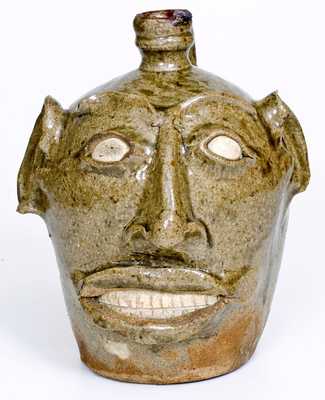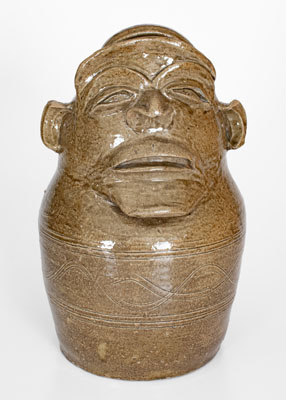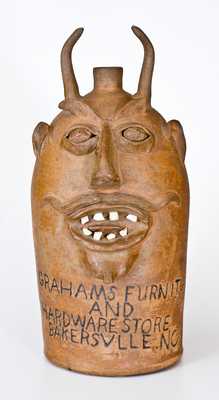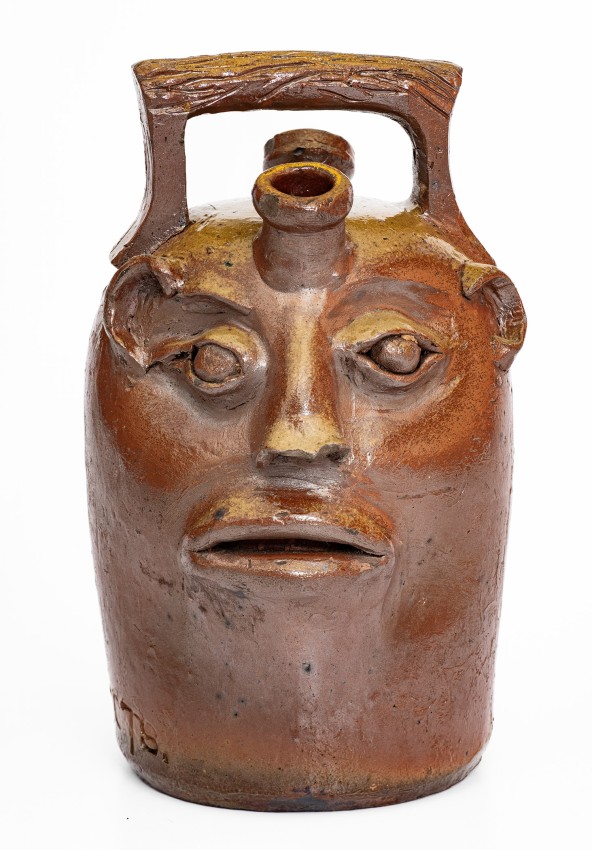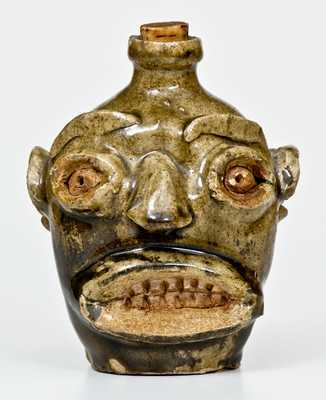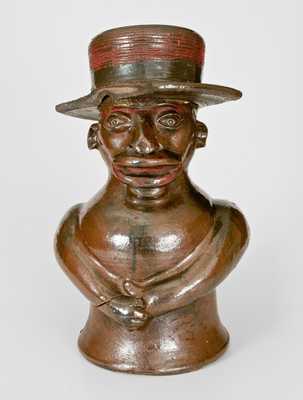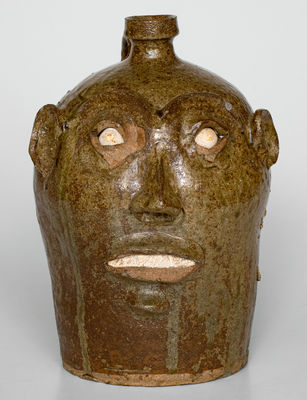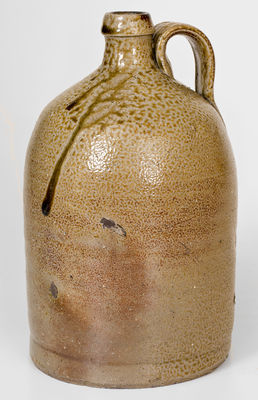Extremely Rare and Important Large-Sized Stoneware Figure of a Preacher, Rock Mills, AL, circa 1880-1890, wheel-thrown figure with clasped hands and brimmed hat, the face with applied and incised features, including eyes with impressed pupils, thick eyebrows with incised hair, a large mouth with incised teeth, a chin, and ears with pierced centers. Reverse of head with applied and lightly-depressed clay representing hair. The figure's hat is wheel-thrown and applied, with heavily-incised rings around the brim, sides, and top. An incised cross on the reverse may represent an individual potter's signature or simply indicate the figure's Christian faith. A circular opening in the reverse, carved prior to the sculpture's firing, is possibly a vent hole to prevent damage during the firing process; it may have also served as a flower holder or granted access to the interior for storage. The figure's robust arms include well-defined fingers and impressed finger nails. Two small impressed holes in the underside of each arm likely served as vents during the firing. Surface covered in a streaky Albany slip glaze, with additional red cold-painted highlights to lips, hat, and eyebrows. Loosely-related to the iconic figural jugs of German-born Alabama potter, John Lehman, this folk sculpture ranks among the largest and most expressive figural ceramic works of 19th century America. Enigmatic in its function, this "preacher man" figure may have served some ceremonial purpose in a local church. Adding further intrigue is the oversized vent hole on the figure's reverse, large enough to place objects inside.
Alabama's face vessels, typically potted in a torso form, can be linked to the Edgefield face jug tradition, as many of the potters in this state were trained or influenced by artisans previously operating in Edgefield, South Carolina. As many of Edgefield's face jugs are believed to have been made by potters of African descent, the possibility exists that this figure was made by an African-American potter working in Alabama commemorating a local black preacher or church. Author, John Michael Vlach, in his seminal 1978 book, The African-American Tradition in Decorative Arts, discusses a figure likely by the same maker and its possible African-American origin. With similar form, size, facial structure, and virtually identical hat, Vlach describes this second example as "the masterwork among known ceramic torso figures." He writes, "The best of the Alabama trio is called Preacher Man. It is a bulky figure more than sixteen inches high. . . The overall handling of mass and form in this piece is so impressive that it stands out as the masterwork among known ceramic torso figures. One scholar has remarked that the statue projects a kind of sympathy for a black subject. If, indeed, the figure was meant to depict a black man or preacher, it is a competent and well-executed statement. Since the features of this piece tend to favor abstract presentation over naturalism, it might be classed as a black creation. It is not clear how one safely measures such an intangible as ethnicity in a mute work whose only history is rumor. More information here would be helpful, but it would not be surprising to discover Afro-American origins." (Vlach, pp. 92-93) The vessel Vlach is referring to was previously owned by prominent New York folk art collector, John Gordon, and sold in the 1999 Christie's, New York auction of his collection. It is pictured in Vlach's book, The African-American Tradition in Decorative Arts, as well as Robert Charles Bishop's well-known book, American Folk Sculpture. As stated, a number of clear stylistic similarities link this face vessel to the example offered in this auction. However, the face on the vessel to be auctioned is arguably more well-executed and expressive, clearly noted in the construction of the eyes. Gordon's example features sunken eyes assuming a somber tone. The eyes on the figure to be auctioned are bulging and lively with impressed pupils, creating a more pleasant or satisfied facial expression to the preacher. In addition, this figure's mouth, with its pinched, upward curling ends, creates a sort of smile, which is markedly different than the mouth of the Gordon example.
If Vlach's suggestion regarding an African-American origin is correct, one possible maker is Edward "Ed" Rushton, listed in Brackner's Alabama Folk Pottery, p. 248. Born circa 1825-1830, Rushton was an ex-slave to the South-Carolina-trained Rushton family of potters. According to Brackner "in 1880, he lived near and probably worked for Ussery and Lane, but in 1900, he probably worked for Pittman Brothers" (Brackner, p. 248). Few American face vessels of this size and quality are ever made available on the secondary market. Awe-inspiring in form, size, and sentiment, this work ranks among the greatest ceramic objects ever produced in the state of Alabama. Literature: For similar examples, see Christie's, Jan. 15, 1999, The John Gordon Sale of Folk Americana, lots 1167 and 1168; see also p. 220, fig. 412 of American Folk Sculpture by Robert Charles Bishop. For more information on Alabama face vessels and additional photos of similar examples, see also pp. 92-93 of The African-American Tradition in Decorative Arts by John Michael Vlach, University of Georgia Press, 1978. Provenance: Crocker Farm, Inc., July 19, 2014, lot 58. Two large losses to hat. A very stable, in-the-firing separation at wrist. Minor chips to one eye and minor wear to edge of one nostril. Small chips to opening on reverse. H 16 3/4".

















